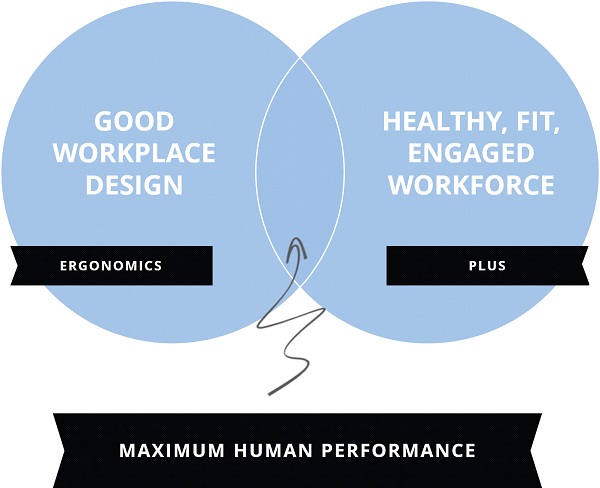In the previous post in this series we outlined two of the biggest MSD prevention mistakes we see today.
- To do nothing. To wait until someone develops an MSD and then treat them with surgery, prescription medications, etc.
- To implement programs independently of each other. Many companies try to implement ergonomics, pre shift stretching, employee education, wellness and many other programs aimed at improving musculoskeletal health independently of each other. This results in an unorganized and inefficient approach.
Over two decades of experience has taught us that a comprehensive and integrated approach will get the best results in the long run.
These programs need to work together to reduce injury risk and promote worker health and human performance.
Maximum human performance is achieved at the intersection of good workplace design and a healthy, fit and engaged workforce.
A comprehensive process is one that:
- improves workplace design through a systematic ergonomics improvement process, and
- creates a healthy, fit and engaged workforce through a systematic education and training process, early intervention and involving workers in the ergonomics improvement process.
How do you get there?
That’s what we’re about to cover. Let’s dig in.
Commit to Prevention
First, leadership at your plant has to be 100% committed to the prevention process. As Tom Peters once said, “Culture eats strategy for breakfast.” If leadership doesn’t fully commit, it will be an uphill battle to build the culture you need to implement a comprehensive and integrated prevention strategy.
Identify one person to be the “MSD Prevention Champion” – if you’re reading this, that’s probably you!
(How’s your culture? Find out here – 25 Signs You Have an Awesome Safety Culture.)
Conduct an Initial Audit
To start building your blueprint for success, you need to know how advanced your current process is in order to make improvements. A good start would be to download our comprehensive annual audit. You’ll get a score from 0 to 100 for each element of the E+ System and an overall grade for your process.
From there, you can identify your strengths and learn where you need additional help.
Establish Written MSD Prevention Guidelines
Written guidelines need to be established for your MSD prevention process and communicated to all employees. This provides a clear blueprint and plan for success. Without written guidelines, your process will blow over in whichever direction the wind is traveling on that particular day.
Assign and Communicate Process Responsibilities
Within your written guidelines, you should include specific roles and responsibilities for everyone at your facility. Communicate these early and often, and make it clear how each party will be held responsible for getting their job done.
Conduct Initial Training
Conduct initial training to educate and empower each individual to be successful at meeting their role and responsibility. A well-equipped and well-trained workforce is critical to this process.
Establish the E+ System
Establishment. Establishment is the element you’re currently reading about and working through. This is the foundation and lasting blueprint for success. It begins with a long-term vision that prevention is better than treatment and ends with a culture of safety, wellness and human performance that is hungry for continuous improvement.
Education. Education and training ensures you have a well-trained and well-equipped workforce to support the process. Group training and one-on-one follow up sessions make sure the message is getting through and that learning objectives are being translated into real-world skills.
Early Intervention. We know that MSDs develop over the course of time – this means that the early warning signs of future injuries are present in your workforce today. Early intervention is a proactive strategy to discover early warning signs of future injuries and put control measures in place to prevent them.
Ergonomics. The ergonomics improvement process systematically identifies and removes ergonomic risk factors contributing to MSDs. The goal is to make continuous improvement to the workplace to make sure each workstation is within the capabilities and limitations of the employee you are asking to do the job.
Evaluation. Results are the name of the game. Monthly and annual evaluations of the process provide insight for continuous improvement opportunities and proof of the effectiveness of the process.
All of these elements must be implemented together and work in harmony to achieve the best results!
Additional elements of the E+ System not specifically mentioned above but worth mentioning here are:
- Building wellness into the lives of workers and their families
- Job rotation evaluation
- Pre-shift stretching
- Return to work guidelines
- Workplace Athletic Training / Sports Medicine Model of injury prevention and human performance
In Conclusion
Establishing a culture of safety, wellness and human performance at your facility won’t happen overnight. It’s a process that takes time and energy. Establishing the process described above will get you there.
It’s worth the effort.
Think prevention!


